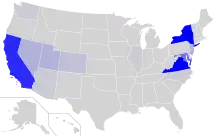| Total population | |
|---|---|
| 538,554 (2021) (Estimate)[1] | |
| Regions with significant populations | |
| New York City, San Francisco Bay Area, Virginia, Los Angeles Texas, Washington, New Jersey, Pennsylvania, Maryland, Alabama | |
| Languages | |
| American English · Pashto Dari and Hindi Urdu spoken as second/third languages | |
| Religion | |
| Sunni Islam, Shia Islam, Christianity, Sikhism, Judaism, Hinduism | |
| Related ethnic groups | |
| Pashtun diaspora Afghan diaspora, Pakistani diaspora, |
Pashtun Americans (Pashto: د امريکا پښتانه) are Americans who are of Pashtun origin, an Eastern Iranian ethnic group originating from Afghanistan and Pakistan.[2]
Demographics

In the United States, there are 538,554 Pashtuns. Pashtun Americans are a sub-community within the wider Pakistani American and Afghan American communities. Areas with large populations include New York City, where there are over 12,000 Pashtuns,[3] as well as the San Francisco Bay Area, Virginia, Los Angeles, Georgia, Chicago metropolitan area, the Dallas-Fort Worth metroplex, and Oregon. Fremont, California has the largest Afghan community in the United States.[4] According to the 2010 Census, 15,788 individuals identified Pashto as their first language spoken at home.[1] Pashtun-Americans are categorized as White-Americans under the US census.[5]
Military
A small number of Pashtun Americans have served in the United States Armed Forces, in varying roles in the War in Afghanistan. Lieutenant Colonel Asad A. Khan, a Pakistani-American marine, was a member of one of the first conventional units to enter Afghanistan.[6] Khan would return to Afghanistan in command of the 1st Battalion 6th Marines in 2004; only to be later relieved of command.[7] Pfc. Usman Khattak, an ethnic Pashtun from northwest Pakistan, is a US Army Food Specialist with the 539th Transportation Division and is based at the US Army camp in Kuwait.[8]
Media
The Voice of America has a Pashto language service.[9]
Organizations
The Pakhtoon American Community Association (PACA) is a cultural association based in Maryland, which organizes an annual Pashto Conference, in addition to other events.[10][11] The Khyber Society, founded in 1986 in New York, also arranges cultural events.[3]
See also
References
- 1 2 "US Census 2010 (see row# 89)". U.S. Census Bureau.
Table 1. Detailed Languages Spoken at Home and Ability to Speak English for the Population 5 Years and Over for the United States: 2006-2008
- ↑ Siddique, Abubakar (2014). The Pashtun Question: The Unresolved Key to the Future of Pakistan and Afghanistan. Oxford University Press. p. 12.
- 1 2 Zaheer, Mohsin (6 January 2011). "'I Am a Khan, I Am Not a Terrorist' Say Pashtuns in New York". Feet in 2 Worlds. Retrieved 24 August 2015.
- ↑ Robson, Barbara; Lipson, Juliene (2002). "The Afghans: Their History and Culture" (PDF). Center for Applied Linguistics.
- ↑ "In the Matter of K, 2 I&N Dec. 253 | Casetext". casetext.com. Retrieved 2023-09-14.
- ↑ Tempest, Rone (25 May 2002). "U.S. Heroes Whose Skills Spoke Volumes". Los Angeles Times. Retrieved 20 November 2014.
- ↑ Lowrey, Colonel Nathan S. (2011). U.S. Marines in Afghanistan, 2001-2002: From the Sea (PDF). Washington, D.C.: History Division, United States Marine Corps. pp. 299–300. ISBN 978-0-16-089557-9. Archived from the original (PDF) on 2014-11-29.
- ↑ Roesch, Kelli (13 May 2009). "Pakistani-American Soldier Compelled to Serve in U.S. Army". DVIDS. Retrieved 15 November 2014.
- ↑ "Homepage". Pashto VoA. Retrieved 24 August 2015.
- ↑ "Homepage". Pakhtoon American Community Association. Retrieved 24 August 2015.
- ↑ Sherazi, Zahir Shah (3 September 2013). "Portraying the true face of Pashtuns to the world". Dawn. Retrieved 24 August 2015.
12. ^ 42% of 200,000 Afghan-Americans = 84,000 and 15% of 363,699 Pakistani-Americans = 54,554. Total Afghan and Pakistani Pashtuns in USA = 238,554.

